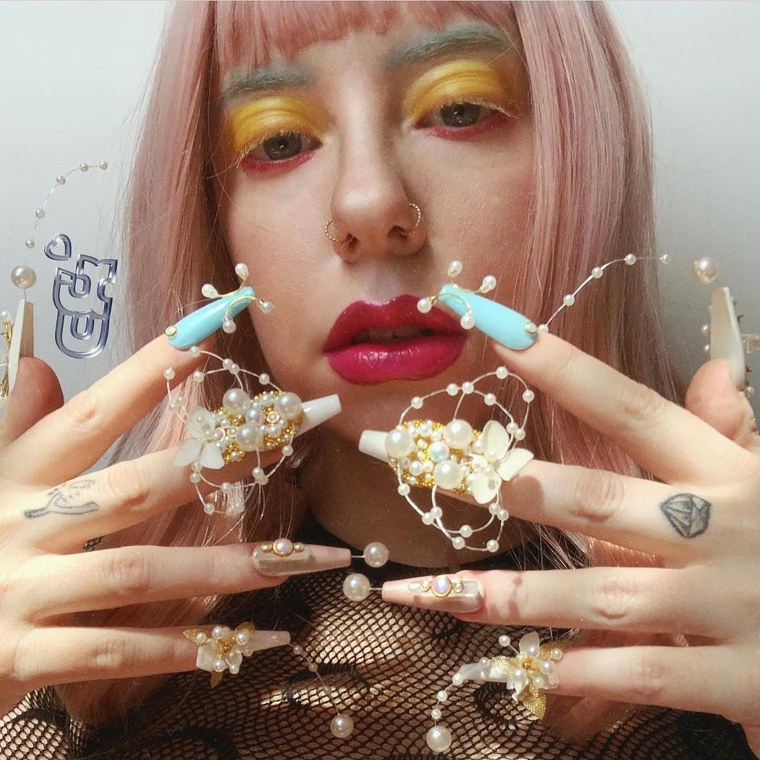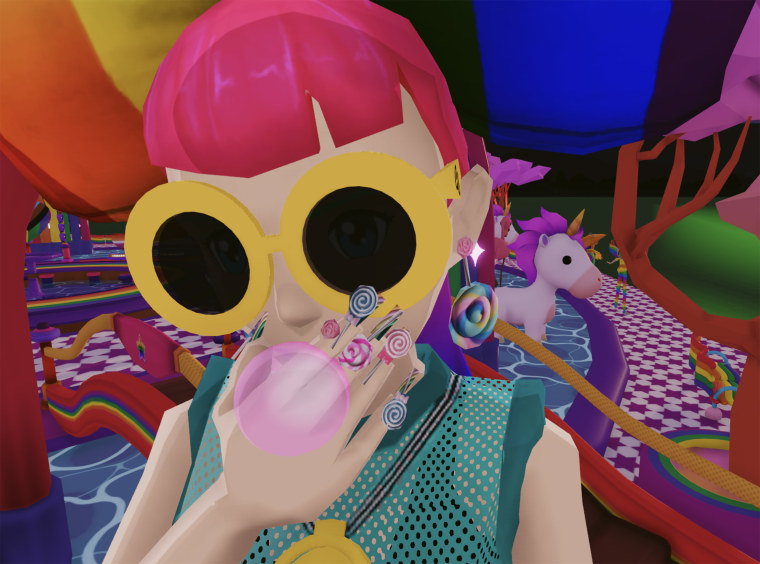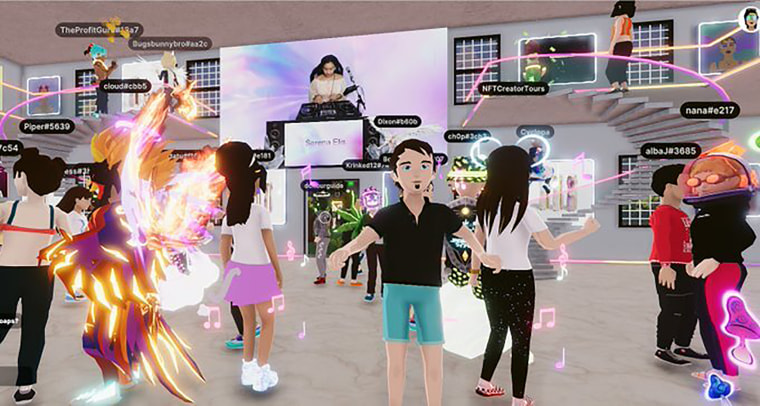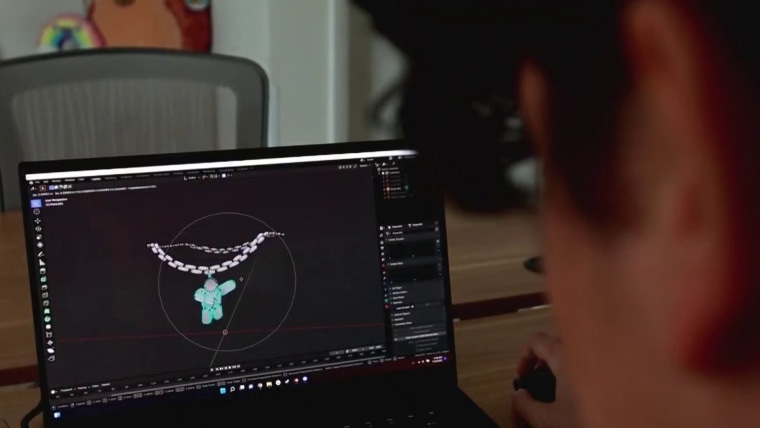
Making money in the metaverse: Inside the new digital side-hustle
Most days, Nikki Fuego hurries through her day job duties in just a few hours, squaring away customer service issues for an exercise equipment startup before settling down to her real work — designing horned bodysuits and glimmering geometric helmets that can’t be worn or touched.
Fuego is among the growing cohort of people turning to the metaverse for extra income, parlaying hobbies into sometimes lucrative side hustles across a series of virtual spaces that proponents see as the future of the internet.
Betting that the metaverse will soon become the main place where people shop, work and play, businesses and investors have poured money into building out its digital and physical infrastructure — which ranges from virtual reality headsets to video-game-like environments like Roblox and Decentraland. As gamers, tech wonks and deep-pocketed advertisers have flocked to the metaverse, aspiring solopreneurs have followed.

“I am gagged every single day that I wake up and remember I make money from this,” said Fuego, a 29-year old artist in Kansas City, Missouri.
For more than 40 hours a week, Fuego sits in front of her computer with the design software Blender. She uses the program to manipulate points on a mesh graphic, sculpting original accessories to be donned by avatars, the animated characters that people steer through virtual spaces. Her own, which she uses in Decentraland, wears a skintight red and black bodysuit, a black visor and red hair that splits into horns.
A single piece in Fuego’s digital apparel collections can take anywhere from several hours to a whole a month to complete. They’ve sold for between two and 175 Mana, the Decentraland currency that’s roughly equivalent to a U.S. dollar. Over the past eight months, Fuego says she’s earned about $40,000 selling her digital wares — more than four times her monthly day-job income.
“I would have never thought that I would be making money from making digital items that don’t exist and paying my bills,” said Fuego. “That’s literally an artist’s dream, and I’m living it.”
Small businesses, digital designers make millions in metaverse
Aug. 9, 202203:38With Roblox, Fortnite and Minecraft collectively boasting hundreds of millions of users, there is growing demand for avatar accessory designers, game developers, consultants and influencers to help accelerate the market for digital goods in the metaverse. While its virtual worlds are ideally navigated in 3D using a VR headset, many are still largely in nascent stages and often simulate browser-based video gaming. Today, anyone with a computer and internet connection can explore Roblox, the Sandbox or Decentraland as a digital avatar and buy goods on their respective marketplaces with cryptocurrencies tied to each one.
“People often think, ‘What’s the new job in the metaverse?’ And it’s actually creating interesting things that people would actually do when they get to the metaverse,” said Jeremy Bailenson, founding director of Stanford University’s Virtual Human Interaction Lab. “Sometimes it’s engineering, where you’ve got to build software and hardware. Sometimes it’s simply by showing up and being a character in a type of an event.”
The avatar accessories, which are also called “skins,” can be anything from a pair of elf ears with piercings to a floating rainbow-colored flame aura. Or you can simply outfit your avatar in head-to-toe Prada and Balenciaga.
And thanks to creators like CK Bubbles, avatars can deck out their nails as well. The 36-year-old New Yorker, who uses they/them pronouns, began designing physical nail art out of their home after losing their job at the height of the pandemic in 2020. But after seeing the musician Grimes perform in Decentraland in March, CK Bubbles thought they’d try doing nails in the metaverse.

They snapped a few photos of real-world nail sets they’d already made and sent them to a digital designer known as Mana Daiquiri. In one collection the two developed together for LGBTQ Pride, the virtual nails are spangled with lollipops and bows. Another set glimmers in purple opal and shimmering gems. Without any promotion, CK Bubbles said they sold about 30 nail sets for about 10 Mana amounting to around $300.
CK Bubbles’ primary income comes from their work as a creative director in advertising, but they said the avatar nail-art side hustle is more than a hobby. “[The metaverse] has really just exploded in ways I didn’t anticipate, to the point that it will hopefully be my full-time business,” they said.

Major brands are eyeing the metaverse’s growth potential too. Already, the market is estimated to reach $783.3 billion by 2024, a 63% increase from 2020, according to Bloomberg Intelligence. Within the past year, brands from Snapple and Gucci to JPMorgan Chase have each invested millions of dollars to scoop up virtual land in the metaverse where they can roll out games and sell exclusive items. Meta Platforms CEO Mark Zuckerberg is reorienting the tech giant around the metaverse, saying earlier this year that he expects virtual worlds to drive hundreds of billions of dollars in digital commerce within the next decade.
To get there, companies are spending heavily on developers who can build out rich experiences in virtual spaces and on influencers who can lure people there. As a result, much of the metaverse smacks of marketing, but that can still mean money in tech-savvy side-hustlers’ pockets.
Meta is testing new bonus programs for creators in its metaverse platform, called Horizons World, that reward them for the time users spend in their worlds within it. The Sandbox’s creator fund pays people anywhere between $2 and $60 for original art pieces that the company can sell on its marketplace. Roblox told investors in November last year that nearly 1,000 developers had earned more than $30,000 over the previous 12 months.
Serena Elis, a 31-year-old former real-estate agent in The Villages, Florida, saw the metaverse as the break she needed in her budding singing career. After experimenting with cryptocurrency and streaming on Twitch, she decided to host her first event in Decentraland in 2020, performing a few of her synth-pop songs. Only a few people showed up, but she said she saw enough interest to keep going.

Over the past two years, her metaverse pursuits have expanded, partly thanks to brand partnerships. In January, she performed at the virtual launch of indie lipstick brand Valdé Beauty and created a limited-edition crystal quartz lipstick vessel and nonfungible token (NFT) art pieces for the company. She also performed during Metaverse Fashion Week for the nonprofit Crypto Chicks, which educates women in blockchain, cryptocurrency and other emerging technologies.
Elis now estimates that she earns the crypto equivalent of up to $2,500 a month from her metaverse gigs and collaborations. That’s still well shy of the $4,000 to $10,000 a month she made as a real-estate agent before leaving the field a year ago, and she says she’s been tapping her savings to help cover expenses since then. Elis says she doesn’t cash out her cryptocurrency earnings and has few bills to pay, adding that she saves on rent while living with her mom — who doesn’t quite understand what she does.

“I know it’s really risky,” Elis said. “But I really, genuinely believe in what I’m doing.”
Nikki Fuego said she sees a path to leaving her customer service job and taking her metaverse projects full-time. She recently ventured into “wearables” for virtual cars in a Decentraland game she helped create, in which gamers can buy an avatar that transforms into a glowing vehicle resembling their character’s design. She said she has already sold hundreds of pieces for up to $175 each.
Source: https://www.nbcnews.com/business/business-news/metaverse-make-money-avatars-decentraland-rcna41336







